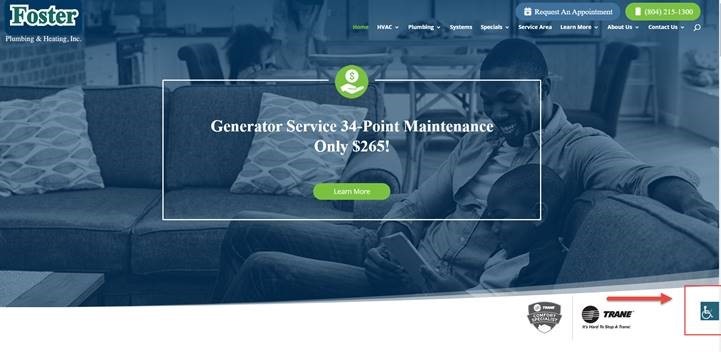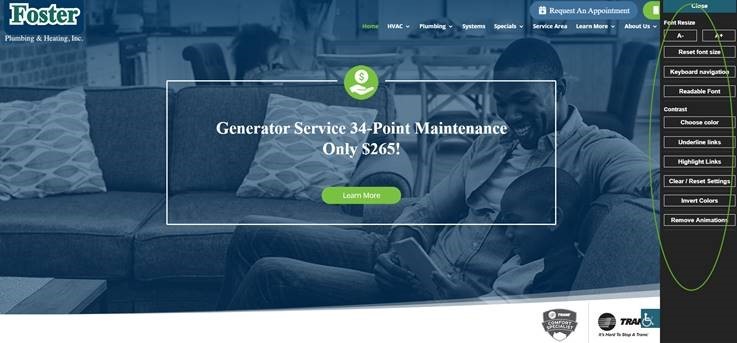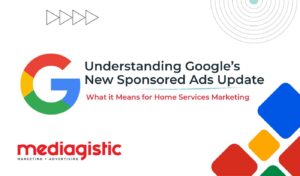
Why Mediagistic is Investing in ADA-Compliant Websites at Zero Cost to Our Clients

After a great deal of consideration, Mediagistic has decided to make all our sites compliant with Americans with Disabilities Act (ADA) standards. Although this move comes at no cost to our clientèle, it requires a significant ongoing investment on the part of our agency.
Our leadership team has concluded, however, that this is a necessary — and indeed ethical — course of action. We’ve made this decision in a good-faith effort to protect our agency’s clients from litigation and help expand their business practices to become more inclusive. Read on to learn what ADA compliance is, how it applies to a digital context, why we feel it matters for businesses of all sizes, and what we’re doing to ensure our clients have ADA-compliant websites.
What is ADA Compliance?
When most people think about ADA compliance, images of wheelchair ramps and elevators immediately come to mind. The act established building codes in 1990 requiring all new construction and renovations to be accessible for individuals with disabilities. Title III of this statute additionally defines discrimination on the part of businesses and commercially operated facilities as a failure to “remove architectural barriers in existing facilities when it is ‘readily achievable’ to do so.”
And this tends to be the limited context in which the average business owner understands this set of laws. However, as more and more of our lives have moved onto the web, these guidelines naturally have grown to encompass the digital sphere. After all, the world’s largest retailer now does almost all of its business exclusively online, and everyone loves next-day shipping, don’t they?
Why is ADA Compliance Important?
First and foremost, any effort your brand can make in the name of inclusivity — including ADA compliance — simply is the right thing to do. Nobody should be disincluded on the basis of race, gender identity, belief system or disability. And in recent years, there’s been a unilateral push for businesses in every industry to become more inclusive. Google, for example, created a dedicated “product inclusion” team in 2017 solely for the purpose of ensuring inclusivity for its vast ecosystem of products.
Additionally, it turns out that ADA compliance is an excellent business practice. According to a 2018 study conducted by the Centers for Disease Control (CDC), 61 million US adults — or 25% of the population — suffer from a disability that impacts major life activities.
These individuals not only are potential customers, but they’re also more likely to become loyal customers for your brand. As the U.S. Department of Justice’s Civil Rights Division observes, “People with disabilities and older adults who benefit from accessible features are likely to become repeat customers for businesses that provide them with accurate information, informed assistance, and a friendly attitude.”
Finally, the potential repercussions of non-compliance have become high-stakes and well-documented. Lawsuits abound against a cavalcade of celebrities and brands, including Beyonce, Pharrell, Kylie Jenner, Hulu, the University of California Berkeley, Target, Home Depot, Hooters, Sephora, Helzberg Diamonds, Kmart, Hugo Boss, CVS Pharmacies, Chick-Fil-A and many more.
Perhaps most notably, Domino’s Pizza attempted to take its civil suit to the Supreme Court only to have the petition denied in October 2019, meaning the lower court decision against the brand was upheld. According to the Motley Fool, this threatens every site on the web: “As the law continues to be clarified in this area, expect continued lawsuits from enterprising plaintiffs’ attorneys and heightened legal risk for businesses developing online ordering technology.”
What Does ADA Compliance Mean for Your Website?
Whether you’re operating a brick-and-mortar establishment or your business is wholly online, your brand’s website should be accessible and easy to use for everyone.
Particularly for low- or no-sight consumers, however, this scenario usually is not the case. Even with assistive technology (AT) — which includes screen-reading software like JAWS — it’s often very difficult to complete basic online transactions such as purchasing airline tickets, booking hotel rooms, shopping for common household products or ordering food for delivery. Most websites simply are missing the necessary code, metadata and design attributes required to make the user experience translate properly via AT software.
Ensuring website accessibility can be a tricky proposition, though. There are no formal government standards for private businesses to ensure ADA compliance. With no formal framework in place, basic user experience principles guide the way. According to a piece published recently in the Los Angeles Times:
“For a website to be accessible to disabled people, the content must be coded so that screen-reading software can convert the words to an audio translation. Video that appears on a website must include descriptions for the deaf. Also, all interactive functions must be operable through keyboard commands for people who can’t use a mouse.”
Across the web, however, the ruled in 2016 that UC Berkeley should refer to these guidelines to make its own site compliant, lending credibility to WCAG as the current benchmark for accessibility. Under WCAG 2, there are three levels of conformance:
- Single A Compliance: This tier includes simple, low-hanging fruit like using descriptive alternative text (i.e. alt-text) on your site’s images so that they can be interpreted by screen-reading software.
- Double A Compliance: This level of compliance is substantively more difficult to meet. It includes everything encompassed by Single A and everything outlined above; including screen-reader-friendly coding, captioning in videos, keyboard-operable interactive functions, header tags, differentiated navigation and content, and more.
- Triple A Compliance: The highest standard of conformance includes advanced technologies and items that generally go beyond the capabilities of a typical business or brand. A salient example is having sign language features for any onsite video content that includes audio over video. Major news organizations and very large multinational brands generally swim in these waters.
For most businesses, double A compliance should generally meet the standard of “readily achievable” accommodations under the ADA. Consult the full list of WCAG 2 success criteria by level, though, and speak with your attorney to determine which level of WCAG 2 conformance is most advisable for your business.
What is Mediagistic Doing to Ensure ADA-Compliant Websites?
Although Mediagistic’s sites have always adhered to general World Wide Web Consortium (W3C) guidelines, our design and development teams have taken a number of steps in recent months to ensure a standard of double A compliance has been met. These are the steps we’ve taken:
- Reviewing site code to ensure screen-reading software can reasonably interpret site copy into an audio translation.
- Adding a new website accessibility policy to the footer of all sites that will look similar to this:
- Adding Web Accessibility features that will appear to the user with a small handicapped symbol on the bottom right side of the screen :
- When users click on the icon, a side bar will open up that will allow modification of the site to meet their particular needs:
- Updating all alt tags with descriptive text of what the image is (ex. HVAC contractor repairing AC unit instead of just AC Repair)



Have questions about your website? The Mediagistic team specializes in building easy-to-navigate websites to minimize user friction, increase inclusivity and maximize revenue potential. Contact us today to learn how an intuitive website and a strong digital marketing strategy can grow your business.
Eddie Childs is the Senior Inbound Marketing Manager for Mediagistic. His writing has been published by a range of websites and publications including Copypress.com, Jambase.com, NFLSoup.com, FootballNation.com, and Boating World, KnowAtlanta, Men’s Book, Cobb in Focus, TCL, Blush, Charged Electric Vehicles, Business to Business, and Catalyst magazines. Follow him on Twitter and connect with him on Linkedin.
Featured image via Getty Images
You May Also Like

Google’s “Have AI Get Prices” Feature: Rewriting Local Search for HVAC & Home Services
December 15, 2025In recent months, Google has quietly rolled out a major update to local search with its new “Have AI Get Prices” functionality,… Continue Reading Google’s “Have AI Get Prices” Feature: Rewriting Local Search for HVAC & Home Services…

Mediagistic Announces Strategic Partnership with EGIA to Deliver Enhanced Marketing Solutions for Home Services Contractors
November 10, 2025Tampa, FL – Mediagistic, a full-service marketing and advertising agency specializing in contractors and service-based businesses, today announced a strategic partnership with… Continue Reading Mediagistic Announces Strategic Partnership with EGIA to Deliver Enhanced Marketing Solutions for Home Services Contractors…

Understanding Google’s Sponsored Results Update: What it Means for Home Services Marketing
October 20, 2025Google is once again reshaping how paid ads appear in search results, and this change (called the Google Sponsored Results Update) could… Continue Reading Understanding Google’s Sponsored Results Update: What it Means for Home Services Marketing…